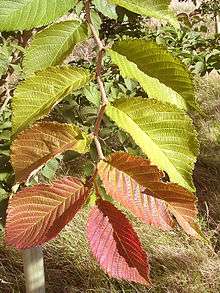Ulmus 'Morton Red Tip' Danada Charm
| Ulmus hybrid cultivar | |
|---|---|
 | |
| Hybrid parentage | Ulmus 'Morton' = Accolade open pollination |
| Cultivar | 'Morton Red Tip' = Danada Charm™ |
| Origin | USA |
Ulmus 'Morton Red Tip' (selling name Danada Charm) is a hybrid cultivar raised by the Morton Arboretum from an open pollination of Accolade. The tree has occasionally been reported as a hybrid of Accolade with the Siberian Elm Ulmus pumila,[1] an error probably owing to the commercial propagation of the tree by grafting onto U. pumila rootstocks.
Description
Danada Charm has a graceful, vase-shaped habit resembling the American Elm Ulmus americana with foliage tinged red on emergence.
Pests and diseases
Although highly resistant to Dutch elm disease, Danada Charm is very susceptible to the elm leaf beetle Xanthogaleruca luteola [2], Japanese Beetle,[3] and Gypsy moth; it is also moderately preferred by cankerworms.[4][5]
Cultivation
Danada Charm is very cold hardy; in artificial freezing tests at the arboretum [6] the LT50 (temp. at which 50% of tissues die) was found to be - 31 °C. However, the tree is notorious for its stem breakage owing to narrow crotch angles and included bark; in trials at the University of Minnesota it had the unhappy distinction of being the worst of 17 cultivars for breakage.[7] The tree is currently being evaluated in the National Elm Trial coordinated by Colorado State University.
Danada Charm is being promoted by the Chicagoland Grows corporation but is not widely available in the United States. Very rare in Europe, it is not known (2016) to have been introduced to Australasia.
Etymology
Danada Charm is named for the Daniel F. & Ada L. Rice Foundation, which helped sponsor the elm breeding program at the Morton Arboretum.
Accessions
- North America
- Brenton Arboretum, Dallas Center, Iowa. No details available.
- Chicago Botanic Garden, Glencoe, Illinois. 2 trees. No acc. details available.
- Dawes Arboretum , Newark, Ohio. 2 trees. No acc. details available.
- Morton Arboretum. Acc. no. 60–2003.
- University of Idaho Arboretum. Acc. no. 1998012
- Europe
- Grange Farm Arboretum, Sutton St. James, Spalding, Lincolnshire, UK. Small plants (2016). Acc. details not known.
Nurseries
- North America
- J. Frank Schmidt & Son Co. , Boring, Oregon
- Johnson's Nursery , Menomonee Falls, Wisconsin
- Sun Valley Garden Centre , Eden Prairie, Minnesota
References
- ↑ http://www.fs.fed.us/psw/programs/cufr/products/CUFR_780_Elm_trials_2009.pdf
- ↑ McPherson, G. et al. (2008). National elm trial: Initial report from Northern California. Western Arborist, Fall 2009, pp 32-36.
- ↑ Brady, C., Condra, J., & Potter, D. (2008) Resistance of Landscape-suitable Elm (Ulmus spp.) Cultivars to Japanese Beetle, Leaf Miners, and Gall Makers. 2008 Research Report, Nursery & Landscape Program, pp 15, 16. University of Kentucky.
- ↑ Guries, R. P. & Smalley, E. B., (1986), Proc. Third Nat. Urban Forestry Conf., pp 214–218, 1986, Orlando, Florida.
- ↑ Santamour, Frank S.; Bentz, Susan E. (May 1995). "Updated Checklist of Elm (Ulmus) Cultivars for use in North America". Journal of Arboriculture. 21 (3): 122–131. Retrieved 20 June 2016.
- ↑ Shirazi, A. M. & Ware, G. H. (2004). Evaluation of New Elms from China for Cold Hardiness in Northern Latitudes. International Symposium on Asian Plant Diversity & Systematics 2004, Sakura, Japan.
- ↑ Giblin, C. P. & Gillman, J. H. (2006). Elms for the Twin Cities: A Guide for Selection and Maintenance. University of Minnesota.
External links
- http://fletcher.ces.state.nc.us/programs/nursery/metria/metria11/warren/elm.htm Warren, K., J. Frank Schmidt & Son Co. (2002). The Status of Elms in the Nursery Industry in 2000.
- http://www.mortonarb.org/plantinfo/plantclinic/phc/New-Elms-For-The-Landscape.pdf. Miller, F. (2002). New elms for the landscape and urban forest.